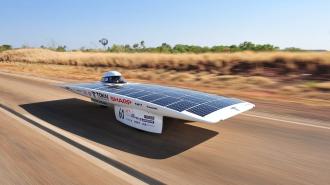Solar cars exist. The best place to see them is the World Solar Challenge, a race that’s held every two years in Australia. Competitors have to drive about 1,870 miles (3,000 kilometers), from Darwin on the country’s north coast to Adelaide on its south coast, using only energy from the Sun.
Many cars that compete in this race look more like amusement park rides or science fiction vehicles than the cars you see on the road. That tells you something about why solar cars aren’t an option for everyday travel, at least not yet.
Collecting enough sunlight
While a lot of sunlight falls on Earth during the day, the light becomes scattered as it travels through the atmosphere, so the amount that hits any given surface is fairly low. Averaged out over a full year to remove the effects of different seasons, it’s about 342 watts per square meter, an area equivalent to about 10 square feet. That’s approximately enough power to run a standard refrigerator.
Car sizes vary a lot, but a full-size car in the U.S. is about 18 feet long and 6 feet wide, so it has about 100 to 110 square feet (9 to 10 square meters) of horizontal surface. That would collect roughly 3,420 watts – enough to run a refrigerator, a dishwasher and a microwave oven.
Large solar farms that send electricity to cities and towns compensate for the fact that sunlight is spread across such a large area by putting up millions of solar panels across thousands of acres. Some, mainly in desert areas, use fields of mirrors to concentrate the Sun’s energy. But a standard car doesn’t have enough surface area to collect a lot of solar energy.
Turning sunlight to energy
Another issue is that today’s solar panels aren’t very efficient at converting sunlight into electricity. Typically, their efficiency is around 20%, which means they convert about one-fifth of the solar energy that reaches them into electric current.
This means that 3,420 watts of solar power falling on an average car covered with solar panels would yield only about 684 watts that the car could use. In comparison, it takes about 20,000 watts for an electric vehicle to drive at 60 miles per hour (100 kilometers per hour).
Vehicles that compete in the World Solar Challenge tend to be large and have designs that maximize their horizontal surface area. This helps them collect as much sunlight as possible. As a concept vehicle, that’s fine, but most models don’t have many windows, or space for anything except a driver.
When the Sun doesn’t shine
Yet another challenge is that geographic locations, daylight hours and weather conditions all affect how much solar energy can be generated.
The Earth is tilted on its axis, so not all areas receive equal amounts of sunlight at any given time. When the Northern Hemisphere tilts toward the Sun, the upper part of the globe gets more Sun exposure and observes spring and summer, while the Southern Hemisphere is colder and darker. When the southern half of the planet tilts toward the Sun, areas on Earth’s southern half get more Sun and the upper half gets less.
Areas near the equator get consistent sunlight year-round, so zones closer to it – such as Southern California or the Sahara desert – have more intense solar power than places closer to Earth’s poles, such as Alaska.
Solar cars would also struggle to collect enough sunlight on overcast or rainy days. Even big utilities with huge solar farms have to plan for times when the Sun doesn’t shine.
And drivers need their cars to operate at night. In order for a solar car to run after dark, it would need to use extra energy that it collected during the day and stored in a battery. Solar panels and batteries increase the weight of the car, and heavier cars need more power to run.
Researchers are working to design solar cars that are more suitable for everyday use. For this to happen, designers will need to make solar panels more efficient at converting sunlight to energy and design solar panels that are more suitable for cars. It also will be critical to make solar systems for cars cheaper, so average buyers can afford them.
For now, the closest option to a solar car is an electric vehicle that’s charged at home or at a charging station. Depending on how that electricity is generated, some of the energy that flows into these cars is likely from solar panels, wind turbines, hydropower dams or other renewable sources. And that share will rise as states work to switch to clean energy over the next several decades. If you’re driving or riding in an electric car, you might be traveling on solar power right now.
This article is republished from The Conversation under a Creative Commons license. Read the original article.
